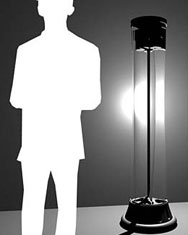
The light that cannot shine
The Treehugger web site has fallen for an obvious bit of hype in featuring a gravity powered light yesterday.
The light won second prize in a green gadgets competition in New York. But much as off-gridders would welcome the product, unfortunately the design is flawed — as anyone with a little scientific knowledge would recognise.
Treehugger featured the”Gravia” LED floor lamp from designer Clay Moulton which claims to that combine human power and gravity to create a lighting source that will work for 200 years with no external power. The design, part of his master�s thesis at the College of Architecture and Urban Studies should never have been passed by his academic minders.
It features a weight that’s raised every four hours or so; as it slowly descends, the downward motion is converted to torque via a high-efficiency ball screw. The torque is overdriven (at 1:160) by a harmonic drive gear hand, and the output from that spins a set of 12 high-strength neodymium magnets (which act as the rotor), spinning to power 10 high-output LEDs.
Gravia’s light output of 600-800 lumens is roughly equal to a 40 watt incandescent bulb. Moulton has calculated wrongly that, with 8 hours of use 365 days a year, the lamp will last for more than 200 years, and will only get better with age.
But the concept is quite impossible according to Moschops ont he green gadgets blog who Says:
” the Gravia floor lamp would not work. The amount of energy stored by raising a mass is very little and even if there was a 100% efficient generator it would probably only power an LED lamp for a couple of minutes. If you want the math: potential energy of a mass in Joules = m*g*h where m= mass in kg, g = acceleration due to gravity (9.8 m/s^2) and h = height raised in meters. So even if you hauled a massive 100 kg weight (over 200 pounds!) to 2 meters you�d get only 2000 Joules of energy as it descends (and it would take that much to raise it). At super efficient white LED gives around 100 Lumens per Watt of electrical input (depending on color), so to get 600-800 lumens would require at least 5 Watts and 5Watts is 5 Joules per second so 2000 Joules gives you 2000/5 or 400 seconds worth of light – less than 7 minutes. And that assumes a 100 efficient generator whereas you�d probably be looking at more like 50% efficiency so you�d be down to about a couple of minues and all this is with a super heavy weight that would probably require a big winch to raise.”
powkey Portable Power Station 350W, 260Wh/70,000mAh Backup Lithium Battery, 110V Pure Sine Wave Power Bank with 2 AC Outlets, Portable Generator for Outdoors Camping Travel Hunting Emergency
Now retrieving the rating.
$192.98 (as of April 26, 2024 14:01 GMT +01:00 - More infoProduct prices and availability are accurate as of the date/time indicated and are subject to change. Any price and availability information displayed on [relevant Amazon Site(s), as applicable] at the time of purchase will apply to the purchase of this product.)200W Portable Power Station, Powkey 120Wh/33,000mAh Power Bank with AC Outlet, 110V 6 Outputs Solar Generator External Battery Pack with LED Light for Home Use and Outdoor Camping
Now retrieving the rating.
31% OffFoldable Solar Panel Charger 60W with 18V DC Output (11 Connectors) for 100W~350W Portable Power Stations Jackery/Rockpals/Flashfish/Enginstar, Portable Solar Generator for Outdoor Camping Van RV Trip
Now retrieving the rating.
$98.99 (as of April 26, 2024 14:01 GMT +01:00 - More infoProduct prices and availability are accurate as of the date/time indicated and are subject to change. Any price and availability information displayed on [relevant Amazon Site(s), as applicable] at the time of purchase will apply to the purchase of this product.)10W USB LED Light for Camping Garage Warehouse Car Truck Fishing Boat Outdoor Portable Bulb, Emergency Light, Children Bed Lamp
Now retrieving the rating.
$9.99 (as of April 26, 2024 14:01 GMT +01:00 - More infoProduct prices and availability are accurate as of the date/time indicated and are subject to change. Any price and availability information displayed on [relevant Amazon Site(s), as applicable] at the time of purchase will apply to the purchase of this product.)EnginStar Portable Power Station 300W 296Wh Battery Bank with 110V Pure Sine Wave AC Outlet for Outdoors Camping Hunting and Emergency, 80000mAh Backup Battery Power Supply for CPAP
Now retrieving the rating.
15% Off






One Response
I hate my life but at least this makes it beabrlae.